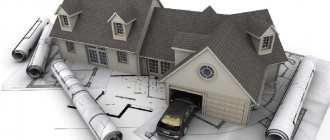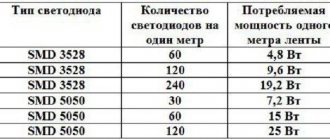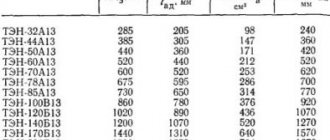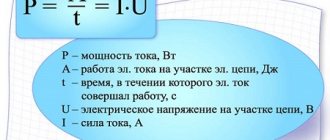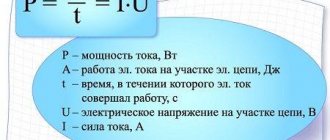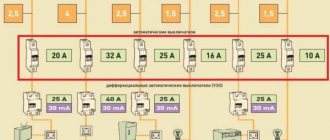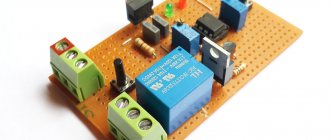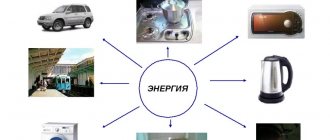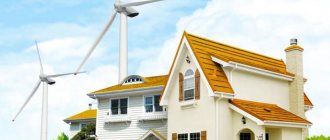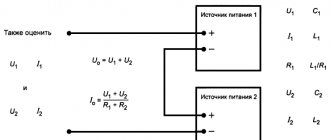How do SES for home work?
Scheme of a solar power plantThe composition of a household power plant includes:
- solar panels;
- batteries;
- charge controller;
- inverter
Electricity is generated by panels that convert the sun's energy into direct current. The principle of their operation is the effect of sunlight on the silicon crystals that make up the solar cells.
The electrons of silicon atoms are released under the influence of radiation and form a current. The resulting charge is accumulated and stored in batteries connected to the panels through the controller.
To obtain an alternating voltage of 220 watts at the output, an inverter is used. It connects to batteries, converting DC voltage into AC voltage.
SES with tracking deviceAlso, if necessary, SES is equipped with a sun tracking device. It rotates the panels so that the sun's rays fall on them at right angles.
Thus, it is possible to significantly increase the efficiency of the system, but this is not always economically justified. They are usually installed if the number of modules is more than eight.
Autonomous solar power plant
As the name suggests, SES of this type are completely autonomous and independent of external centralized power sources.
Small-sized mobile complexes are very popular among autotourists and outdoor enthusiasts who practice multi-day hiking or river swimming. Larger stations are most often installed on dachas and roofs of private houses, where connection to the central power grid is impossible or impractical.
What is included in the kit of an autonomous solar power station
The basic components of an autonomous solar power plant are:
- a set of photovoltaic panels
- transform solar radiation into electricity; - inverter
- converts direct current into alternating current with a voltage of 220 volts; - rechargeable batteries
– accumulate and store excess generation for subsequent power supply of devices at home; - charge controller
– regulating battery charge/discharge; - periphery
- auxiliary elements of the system, including electronics, fasteners, adapters, cables, etc.
Types of autonomous solar power plants
1. Mini solar power plant
It is a small kit in size and weight, with high mobility. As a rule, the elements are placed in a single case, designed in the form of a folding belt or suitcase. It is possible to manufacture a separate panel with output cables - for example, for charging car batteries. Power is about 20-100 W for wearable models and 200-900 W for those transported in a car. 2
2. Autonomous solar power plant for home and garden
It is a complete system for generating electricity of relatively low power - most often 1 - 10 kW. At first glance this is not much. But even one kilowatt of power in the summer at the dacha can provide work throughout the day:
- refrigerator - around the clock;
- a dozen LED lamps, a laptop and five chargers – 5 hours;
- TV – 3 hours;
- electric stoves – 1 hour;
- kettle and microwave - 15 minutes each.
The largest photovoltaic power plants on Earth
[specify
]
Largest photovoltaic installations in the world
| Peak power, MW | Location | Description | MWh/year |
| Abu Dhabi, UAE | 3,200,000 solar modules | ||
| California, USA | 9,000,000 solar modules | ||
| Mojave Desert, California, USA | |||
| California, USA | >1,700,000 solar modules | ||
| Agua Caliente, Arizona, USA | 5,200,000 solar modules | 626 219 | |
| San Luis Obispo, California, USA | |||
| 213 | Charanka, Gujarat, India | A complex of 17 separate power plants, the largest of which has a capacity of 25 MW. | |
| Imperial County, California, USA | >3,000,000 solar modules The most powerful station in the world, using technology to orient modules to the Sun during the day. | ||
| 200 | Golmud, China | 317 200 | |
| Imperial County, California, USA | |||
| Imperial County, California, USA | |||
| Schipkau, Germany | |||
| Clark County, Nevada, USA | |||
| Maricopa County, Arizona, USA | 800,000 solar modules | 413 611 | |
| Neuhardenberg, Germany | 600,000 solar modules | ||
| Kern County, California, USA | |||
| Imperial County, California, USA | 2,300,000 solar modules | ||
| Imperial County, California, USA | 2,000,000 solar modules | ||
| Maricopa County, Arizona, USA | > 600,000 solar modules | ||
| 105,56 | Perovo, Crimea | 455,532 solar modules | 132 500 |
| Atacama Desert, Chile | > 310,000 solar modules | ||
| 97 | Sarnia, Canada | >1,000,000 solar modules | 120 000 |
| 84,7 | Eberswalde, Germany | 317,880 solar modules | 82 000 |
| 84,2 | Montalto di Castro, Italy | ||
| 82,65 | Okhotnikovo, Crimea | 355,902 solar modules | 100 000 |
| 80,7 | Finsterwalde, Germany | ||
| 75 | Samara SES, Samara region | ||
| 73 | Lopburi, Thailand | 540,000 solar modules | 105 512 |
| 69,7 | Nikolaevka, Crimea | 290,048 solar modules | |
| 55 | Rechitsa, Belarus | almost 218 thousand solar modules | |
| 54,8 | Kilia, Ukraine | 227,744 solar modules | |
| 49,97 | SES "Burnoe" from Nurlykent, Kazakhstan | 192,192 solar modules | 74000 |
| 46,4 | Amareleza, Portugal | >262,000 solar modules | |
| Dolinovka, Ukraine | 182,380 solar modules | 54 399 | |
| Starokazache, Ukraine | 185,952 solar modules | ||
| 40 | Orsk SES, Orenburg region | ||
| 34 | Arnedo, Spain | 172,000 solar modules | 49 936 |
| 33 | Courban, France | 145,000 solar modules | 43 500 |
| 31,55 | Mityaevo, Crimea | 134,288 solar modules | 40 000 |
| 18,48 | Soboli, Belarus | 84,164 solar modules | |
| 11 | Serpa, Portugal | 52,000 solar modules | |
| 10,1 | Irlyava, Ukraine | 11 000 | |
| Ralevka, Ukraine | 10,000 solar modules | 8 820 | |
| 9,8 | Lazurnoe, Ukraine | 40,000 solar modules | 10 934 |
| 7,5 | Rodnikovo, Crimea | 30,704 solar modules | 9 683 |
| Batagai, Yakutia | 3,360 solar modules, the largest solar power plant in the Arctic Circle | ||
| Peak power, MW | Location | Description | MWh/year |
Growth of peak powers of photovoltaic stations
| Year(s) | Station name | A country | PowerMW |
| 1982 | Lugo | USA | 1 |
| 1985 | Carrisa Plain | USA | 5,6 |
| 2005 | Bavaria Solarpark (Mühlhausen) | Germany | 6,3 |
| 2006 | Erlasee Solar Park | Germany | 11,4 |
| 2008 | Olmedilla Photovoltaic Park | Spain | 60 |
| 2010 | Sarnia Photovoltaic Power Plant | Canada | 97 |
| 2011 | Huanghe Hydropower Golmud Solar Park | China | 200 |
| 2012 | Agua Caliente Solar Project | USA | 290 |
| 2014 | Topaz Solar Farm | USA | 550 |
| (a) by year of final commissioning |
Solar architecture
There are several main ways to passively use solar energy in architecture. Using them, you can create many different schemes, thereby obtaining a variety of building designs. The priorities when constructing a building with passive solar energy are: good location of the house; a large number of windows facing south (in the Northern Hemisphere) to let in more sunlight in the winter (and conversely, a small number of windows facing east or west to limit the entry of unwanted sunlight in the summer); correct calculation of the thermal load on the interior to avoid unwanted temperature fluctuations and retain heat at night, well-insulated building structure.
The location, insulation, orientation of windows and the thermal load of the rooms must form a single system. To reduce internal temperature fluctuations, insulation should be placed on the outside of the building. However, in areas where internal heating is rapid, where little insulation is required, or where heat capacity is low, the insulation should be on the inside. Then the building design will be optimal for any microclimate. It is also worth noting that the correct balance between the thermal load on the premises and insulation leads not only to energy savings, but also to savings in building materials. Passive solar buildings are ideal places to live. Here the connection with nature is more fully felt, there is a lot of natural light in such a house, and it saves energy.
Passive use of sunlight provides approximately 15% of the space heating needs of a standard building and is an important source of energy savings. When designing a building, passive solar building principles must be taken into account to maximize the use of solar energy. These principles can be applied anywhere and at virtually no additional cost.
During building design, the use of active solar systems such as solar collectors and photovoltaic panels should also be considered. This equipment is installed on the south side of the building. To maximize heat output in winter, solar collectors in Europe and North America must be installed at an angle greater than 50° from the horizontal plane. Fixed photovoltaic panels receive the greatest amount of solar radiation during the year when the angle of inclination relative to the horizon is equal to the latitude at which the building is located. The pitch of a building's roof and its south orientation are important considerations when designing a building. Solar collectors for hot water supply and photovoltaic batteries should be located in close proximity to the place of energy consumption
It is important to remember that the close location of the bathroom and kitchen allows you to save on installing active solar systems (in this case, you can use one solar collector for two rooms) and minimize energy losses for transportation. The main criterion when choosing equipment is its efficiency
Pros and cons of solar power plants
After considering the different types of installations, we can highlight the general advantages of solar power plants:
- Powered by renewable energy sources.
- Most SES can operate in many places around the globe with access to sunlight.
- Virtually no harm to the environment.
- SES does not have moving mechanisms and components used in large quantities. The only exceptions are drives that regulate the position of the installation.
- Solar installations retain their advantages and parameters for at least 25 years. After this, individual indicators may decrease, but the station will still work.
- Significant advantages of solar power plants are the possibility of their use in hard-to-reach places without centralized power supply.
- If necessary, a hybrid solar power plant can be used, combining parts, components, parameters and technical characteristics of several types of electrical installations.
Considering the disadvantages of solar power plants, we should focus on some disadvantages:
- Strong dependence on weather conditions and time of day.
- The need for periodic maintenance. The surfaces of solar panels must be promptly cleaned of dust and other contaminants. Some systems may require ventilation or forced cooling.
- The disadvantages of solar power plants are the negative impact on the ecosystem. For example, birds flying over the installation die instantly.
- Insufficient efficiency of solar panels, their relatively high cost, and the need for expensive additional equipment.
Portable solar power station
Solar power plant for home 5 kW and 10 kW
Solar power plant
Gas turbine power plant (GTPP)
Geothermal power plants (GTPP)
Wind power plants
About the advantages and disadvantages
Now that we have an understanding of what types of solar power plants exist, we can talk about what advantages they provide and what disadvantages they have. Solar power plants have pros and cons:
pros
- It is a renewable energy source.
- They work all over the globe.
- Safe for the environment.
- There are practically no moving components in the design, with the exception of those stations that automatically adjust according to the position of the sun.
- Long service life - from 25 years and above.
- Possibility of operation in the absence of centralized power distribution. For example, if you are planning to create a solar power plant for your dacha, this will not be any problem.
- It is possible to organize a hybrid power plant. For example, wind plus sun.
- In the regions of the Far North - an additional source of energy for the heating system.
Minuses
- Weather and time of day.
- The surface must be clean. Therefore, periodic cleaning is necessary.
- Large areas require ventilation or a forced cooling system.
- There is a residual impact on the ecosystem. Solar vacuum power plants are equipped with mirrors with precise focusing. If a bird falls into the focus of the mirrors, it dies instantly.
- The efficiency of solar panels is relatively low given their high cost.
- Additional equipment required.
And yet, despite the shortcomings of solar power plants, they are being built and are of great importance.
Solar thermal power plants
In addition to directly using solar heat, in regions with high solar radiation it can be used to generate steam, which turns a turbine and generates electricity. Solar thermal power generation on a large scale is quite competitive. Industrial applications of this technology date back to the 1980s; Since then, the industry has grown rapidly. Currently, US utilities have already installed more than 400 megawatts of solar thermal power plants, which provide electricity to 350,000 people and replace the equivalent of 2.3 million barrels of oil per year. Nine power plants located in the Mojave Desert (in the US state of California) have 354 MW of installed capacity and have accumulated 100 years of industrial operation experience. This technology is so advanced that, according to officials, it can rival traditional power generation technologies in many areas of the United States. Projects to use solar heat to generate electricity are also set to begin soon in other regions of the world. India, Egypt, Morocco and Mexico are developing corresponding programs, and grants for their financing are provided by the Global Environment Facility (GEF). In Greece, Spain and the USA, new projects are being developed by independent power producers.
Based on the method of heat production, solar thermal power plants are divided into solar concentrators (mirrors) and solar ponds.
Solar concentrators
Such power plants concentrate solar energy using lenses and reflectors. Since this heat can be stored, such plants can generate electricity as needed, day or night, in any weather. Large mirrors—either point or line focus—concentrate the sun's rays to such an extent that water turns into steam, releasing enough energy to spin a turbine. installed huge fields of such mirrors in the Californian desert. They produce 354 MW of electricity. These systems can convert solar energy into electricity with an efficiency of about 15%.
There are the following types of solar concentrators:
- Solar parabolic concentrators
- Dish type solar installation
- Solar power plants of tower type with a central receiver.
Sunny Ponds
Neither focusing mirrors nor solar photovoltaic cells can generate energy at night. For this purpose, solar energy accumulated during the day must be stored in heat storage tanks. This process occurs naturally in so-called solar ponds.
Solar ponds have a high concentration of salt in the bottom water layers, a non-convective middle layer of water in which the salt concentration increases with depth, and a convective layer with a low salt concentration at the surface. Sunlight falls on the surface of the pond and heat is retained in the lower layers of water due to the high concentration of salt. Water of high salinity, heated by solar energy absorbed by the bottom of the pond, cannot rise due to its high density. It remains at the bottom of the pond, gradually warming up until it almost boils (while the upper layers of water remain relatively cold). The hot bottom "brine" is used day or night as a heat source, thanks to which a special organic coolant turbine can generate electricity. The middle layer of a solar pond acts as thermal insulation, preventing convection and heat loss from the bottom to the surface. The temperature difference between the bottom and surface of the pond water is sufficient to power the generator. The coolant, passed through pipes through the lower layer of water, is then fed into a closed Rankine system, in which a turbine rotates to produce electricity.
Solar power plant
A solar power plant is an engineering structure that converts solar radiation into electrical energy. The methods for converting solar radiation are different and depend on the design of the power plant. All solar power plants (SPP) are divided into several types: 1. Tower-type SPP - based on the principle of producing water vapor using solar radiation. In the center of the station there is a tower 18 - 24 meters high (depending on power and other parameters, the height can be more or less), on top of which there is a water tank. This tank is painted black to absorb heat radiation. Also in this tower there is a pumping group that delivers steam to the turbogenerator, which is located outside the tower. Heliostats are located in a circle from the tower at some distance. A heliostat is a mirror with an area of several m2, mounted on a support and connected to a general positioning system. Depending on the position of the sun, the mirror will change its orientation in space. The main and most difficult task is to position all the station mirrors so that at any moment in time all the reflected rays from them hit the tank. In clear sunny weather, the temperature in the tank can reach 700°C. These temperature parameters are used in most traditional thermal power plants (TPPs), so standard turbines are used to generate energy. In fact, such solar power plants can achieve relatively high efficiency (about 20%) and high power.
2. Dishes-type SPP - uses the principle of generating electricity, similar to that of Tower SPPs, but there are differences in the design of the station itself. The station consists of separate modules. The module consists of a support on which the receiver and reflector structure is mounted. The receiver is located at some distance from the reflector, and the reflected rays of the sun are concentrated in it. The reflector consists of dish-shaped mirrors (hence the name) arranged radially on a truss. The diameters of these mirrors reach Ø2 meters, and the number of mirrors is several 10 meters (depending on the power of the module). Stations can consist of either 1 module (stand-alone) or several 10 modules (working in parallel with the network).
SES using photobatteries are now very common, since in the general case SES consists of a large number of individual photobatteries of varying power and output parameters. These solar power plants are widely used to supply energy to both small and large facilities (private cottages, boarding houses, sanatoriums, industrial buildings, etc.). Photo batteries can be installed almost everywhere, from the roof and façade of a building to specially designated areas. Installed capacities also fluctuate over a wide range, ranging from supplying individual pumps to supplying electricity to a small village.
SES using parabolic concentrators heat the coolant to parameters suitable for use in a turbogenerator. SES design: a long parabolic mirror is installed on special trusses, and a tube is installed at the focus of the parabola through which the coolant (most often oil) flows. Having gone all the way, the coolant heats up and in heat exchangers gives off heat to water, which turns into steam and goes to the turbogenerator.
Combined SES additionally have heat exchangers to produce hot water, which is used both for technical needs and for hot water supply and heating.
In 2021, the first solar power plant in the Russian Federation manufactured using heterostructure technology (HJT) was put into operation in Altai. Solar panels made using this technology combine the advantages of amorphous (thin film) and crystalline technologies, combining high efficiency, high wear resistance and efficiency in capturing scattered and reflected light. Even on a cloudy day or in winter, the panels will be able to catch light energy, and on a hot day they will not lose performance due to overheating of the plates. This made it possible to achieve an efficiency of more than 20%.
On an industrial scale, HJT production was launched at the end of 2021 by HEVEL in Novocheboksarsk. Hevel is a joint venture between RUSNANO and Renova, created in 2009 with the aim of integrating solutions in solar energy. Hevel - builds solar power plants on a turnkey basis: produces panels, installs them, and operates solar power plants.
For 2021, the Ministry of Energy of the Russian Federation has established that the cost of 1 kW of installed solar power plant capacity will be compensated to investors. Investments in solar energy will be compensated, based on the price of 109.5 thousand rubles / kW of installed capacity, - wind power - 103 thousand rubles / kW , — hydropower — 163 thousand rubles/kW. It is necessary to take into account installed capacity utilization factors (IUR) in the Russian Federation: - solar - up to 10%; — wind — up to 20%% — hydropower — up to 40%. That is, a hydroelectric power plant, all other things being equal, will generate 4 times more electricity than a solar power plant of the same capacity.
Types of SES
Solar power plants convert solar radiation energy into electricity. There are two types of SES:
1. photovoltaic solar power plants - directly convert solar energy into electricity using a photovoltaic generator.
2. thermodynamic solar power plants - convert solar energy into thermal energy, and then into electrical energy; The power of thermodynamic solar power plants is higher than the power of photovoltaic plants.
Photovoltaic solar power plants
The main element of photovoltaic solar stations is solar panels. They are made of thin films of silicon or other semiconductor materials and can convert solar energy into direct electrical current.
Photoelectric converters are reliable, stable, and their service life is practically unlimited. They can transform both direct and diffuse sunlight. Light weight, ease of maintenance, modular design allows you to create installations of any power. The disadvantages of solar panels include high cost and low efficiency.
Solar batteries are used to power autonomous low-power consumers, power radio navigation and low-power electronic equipment, and drive experimental electric vehicles and aircraft. It is hoped that in the future they will be used in heating and power supply of residential buildings.
Thermodynamic solar power plants
Thermodynamic solar power plants use heat exchange elements with a selective light-absorbing coating. They are able to absorb up to 97% of the sunlight that hits them. These elements, even due to ordinary sunlight, can heat up to 200°C or more. With their help, water is converted into steam in conventional steam boilers, which makes it possible to obtain an efficient thermodynamic cycle in a steam turbine. The efficiency of a solar steam turbine plant can reach 20%.
Based on this effect, the design of an aerostat solar power station was developed. The energy source in it is a balloon filled with water vapor. The outer part of the cylinder allows sunlight to pass through, and the inner part is covered with a selective light-absorbing coating, which allows the contents of the cylinder to be heated to 150-180°C. The steam produced inside will have a temperature of 130-150°C, and the pressure will be the same as atmospheric. By spraying water inside a cylinder with superheated steam, steam is generated.
Steam from the cylinder is discharged into a steam turbine through a flexible steam line, and at the outlet of the turbine it is converted into water in a condenser. From it, water is pumped back into the cylinder using a pump. Due to the steam accumulated during the day, such a power plant can operate at night. During the day, the power of the turbogenerator can be adjusted according to needs.
The main problem is the method of placing solar balloon power plants. Such power plants can be located above the ground, over the sea or in the mountains. Each case has its pros and cons. Here it is necessary to take into account everything: the length of the steam line, the location of the turbogenerator, and the fact that the cylinders do not interfere with the movement of aircraft.
There are other ways to obtain energy from the sun, and if all the problems can be solved, then the demand for such products may be almost unlimited. With the help of new developments, it will be possible to solve the problems of energy supply to backward, hard-to-reach areas, reduce the consumption of fuel resources in large cities, and protect the environment from excessive pollution by emissions of harmful substances.
Hybrid solar power plant
The hybrid type of solar power plant is a combination of autonomous and network stations. Their price per unit of generating capacity is maximum, but it pays off with expanded capabilities.
The presence, in addition to panels and batteries, of a hybrid inverter gives such an installation the following advantages:
- the ability to save as much as possible on paid energy consumption;
- work completely autonomously during a power outage in the centralized network;
- instantly and automatically switch between operating modes - autonomous, networked or mixed;
- in case of excess generation, part of the electricity can be drained into the central network and, thus, recoup part of the investment.
The only drawback of such a solar power plant is the relatively high cost - up to 1 million rubles for a solar power plant capacity of 10 kW.
SES tower type
Tower solar stations work on the same principle as plate ones. The basis of the system is a tower reaching a height of 18-24 m. It is located in the center of the entire installation. Tower components:
- A reservoir filled with water. To absorb maximum solar radiation, it is painted black.
- Pump group. The resulting steam must be delivered to a turbogenerator, which is what the pump does.
The second component of the station is the heliostats that surround the tower. By being included in the general positioning system, mirrors adjust to the position of the sun, changing their orientation. The temperature in the tank reaches 700 °C in bright sunny weather, and the efficiency is 20%.
Tower-type solar power plants (tower-type solar power plants)
These power plants are based on the principle of producing water vapor using solar radiation. In the center of the station there is a tower with a height of 18 to 24 meters (depending on the power and some other parameters, the height can be more or less), on top of which there is a reservoir with water. This tank is coated in black to absorb heat radiation. Also in this tower there is a pumping group that delivers steam to the turbogenerator, which is located outside the tower. Heliostats are located in a circle from the tower at some distance.
A heliostat is a mirror with an area of several square meters, mounted on a support and connected to a general positioning system. That is, depending on the position of the sun, the mirror will change its orientation in space. The main and most time-consuming task is positioning all the station mirrors so that at any moment in time all reflected rays from them hit the tank.
In clear sunny weather, the temperature in the tank can reach 700 degrees. These temperature parameters are used in most traditional thermal power plants, so standard turbines are used to produce energy. In fact, at stations of this type it is possible to obtain a relatively high efficiency (about 20%) and high powers.
Example: SPP built in Crimea
The largest solar thermal power plants on Earth[edit]
The largest solar thermal power plants in the world
| Power MW | Name | A country | Location | Coordinates | Type | Note |
| 392 | STES Ivonpah | San Bernardino, California | tower | Put into operation on February 13, 2014 | ||
| 354 | Solar Energy Generating Systems | Mojave Desert, California | parabolic cylindrical concentrator | SES consists of 9 stages | ||
| 280 | Mojave Solar Project | Barstow, California | parabolic cylindrical concentrator | Construction completed in December 2014 | ||
| 280 | Solana Generating Station | Arizona | parabolic cylindrical concentrator | Construction completed in October 2013 | ||
| 250 | Genesis Solar Energy Project | Blythe, California | parabolic cylindrical concentrator | In operation since April 24, 2014 | ||
| 200 | Solaben Solar Power Station | Logrosan, Spain | parabolic cylindrical concentrator | 3rd stage completed in June 20122nd stage completed in October 20121st and 6th stages completed in September 2013 | ||
| 160 | Noor I | Morocco | parabolic cylindrical concentrator | with three storages | ||
| 150 | Solnova Solar Power Station | Sanlucar la Mayor, Spain | parabolic cylindrical concentrator | 1st and 3rd stages completed in May 2010 4th stage completed in August 2010 | ||
| 150 | Andasol Solar Power Station | Guadix, Spain | parabolic cylindrical concentrator | Construction certified: Andasol 1 (2008), Andasol 2 (2009), Andasol 3 (2011). Each has a thermal reservoir designed for 7.5 hours of operation. | ||
| 150 | Extresol Solar Power Station | Torre de Miguel Sesmero, Spain | parabolic cylindrical concentrator | Construction completed: Extresol 1 and 2 (2010), Extresol 3 (2012). Each has thermal storage designed for 7.5 hours of operation | ||
| 110 | STES Crescent Dunes | Nye, Nevada | tower | in operation since September 2015 | ||
| 100 | KaXu Solar One | South Africa | parabolic cylindrical concentrator | with 2.5 hour storage | ||
| Power MW | Name | A country | Location | Coordinates | Type | Note |
The largest solar power plants in Russia
In our country, the processing of solar energy into electrical energy on an industrial scale began in 2015. The first to be built was the Batagai solar power plant.
Its peak power reaches 1 MW . Included in the Guinness Book of Records as the northernmost photovoltaic facility (processing solar energy into electrical energy). The station has 3,600 panels that capture sunlight. Allows you to save 300 tons of fuel per year (used in electric generators).
TOP 3 largest solar power plants in Russia
As of Q1 2021:
- Sorochinskaya SES (Uran). Located in the Orenburg region, occupies an area of 0.91 square meters. km . Power – 60 MW . Commissioned at the end of 2018;
- Novosergievskaya solar farm (Neptune). Orenburg region, area of photocells – 0.9 sq. km . Power – 45 MW . The total power of the two stations is enough to supply about 10 thousand private homes;
- Orskaya SES named after. Vlazneva. Launch – December 2015. On an area of 1 sq. km . There are about 160 thousand photocells. Power – 40 MW .
Solar energy is one of the most promising areas at present. It allows you to reduce the burden on the environment and minimize the cost of generating electrical energy. Moreover, the resource is renewable - the Sun will continue to shine for millions of years.
Share
Combined SES
Already from the name it is clear that combined solar power stations combine different types of solar stations. Solar panels and concentrators - dish or parabolic - are often combined. In addition to producing energy at solar power plants, it is possible to provide the population with hot water. Its heating is carried out due to additionally installed heat exchange structures.
The variety of types of solar power plants only confirms that today they are actively developing. In this regard, large companies continue to make serious investments in the construction of such installations. Solar stations pay for themselves in a few years and remain profitable, unlike fossil resources, the prices of which are gradually rising. Existing types of SES continue to be improved in order to eliminate their main disadvantages. In the future, this will allow solar energy to be used to its full potential for both industrial and civil purposes.
Combined solar power plants (Combined SPP)
Combined power plants can combine several types of solar power plants. For example, in one area of the station there will be parallel installations of dish or parabolic type and solar panels. Also, another example would be when heat exchange structures are additionally installed at a solar power plant to produce hot water, which can be used for hot water supply, heating or technical needs.
Often, at solar power plants (SPPs) of various types, heat exchangers are additionally installed to produce hot water, which is used both for technical needs and for hot water supply and heating. This is the essence of combined SES. It is also possible to install concentrators and photovoltaics in parallel on the same territory, which is also considered a combined solar power plant.
Advantages and disadvantages
A set of panels that provide lighting and operation of electrical appliances has the following advantages:
- high quality. Any manufacturer gives a long guarantee for their products, since the solar cells of the system are made of high-quality silicon and are wear-resistant. According to statistics, lighting panels last an average of 26 years;
- reliability. You will be confident that when installed correctly on sunny days, a set of batteries will accumulate enough energy to light or operate appliances. Even on cloudy days, energy from the sun will still accumulate, but in less quantity. And thanks to the battery, it can be used at any time;
- inexhaustibility of resources. Compared to a diesel generator, solar kits do not need to be refueled as the solar radiation they convert is inexhaustible;
- modularity. The system modules practically do not need to be maintained - it is enough to wipe them from dust and remove snow;
- simple connection. Each owner of such kits that ensure the operation of appliances and home lighting can, if desired, increase their power by purchasing and installing additional modules;
- autonomy. Battery owners do not depend on problems in the electrical network, since they provide themselves with energy;
- noiselessness (compared to wind generators).
3 kW Peak Power Solar Power Plant Kit
However, solar energy conversion kits also have disadvantages, including:
- high price. Even though solar panels pay for themselves within a few years, not everyone is willing to make a large one-time expense;
- dependence on solar energy. Photocells will not be able to accumulate energy at night and will accumulate little of it on cloudy days;
- maximum efficiency is ensured only at a certain angle of sunlight - they must hit the silicon wafers at an angle of 90 degrees. Since the position of the Sun changes throughout the day, maximum efficiency is not possible all the time, even on sunny days.
What does battery power depend on?
The panels use highly transparent glass with a reduced iron content and, nevertheless, it reduces efficiency by several percent.
The optimal operating time for the panels is from 9 am to 4 pm – this period accounts for 70% of the generated energy. A battery complex of 1 kW during this time produces 7 kWh of electricity, that is, 210 kWh per month. You can add another 3 kW in the morning and evening. This is ideal. But in reality this figure is less:
- Not all days in a month are sunny. If we take into account rainy and cloudy days, let’s say there were 5 such days - this will already be about 180 kWh
- The duration of daylight hours in winter is shorter; a larger array of batteries or the installation of a wind generator is required.
- Energy is lost in the inverter and battery. Batteries cannot be discharged to 100%, and their efficiency is no higher than 80%.
The amount of energy generated depends on the number of clear days per year
.
Installing a battery will not be advisable, there are less than two hundred sunny days a year. In addition, the sun's rays must hit the panel at right angles - for this it is recommended to install sun tracking systems. These devices are expensive. The quality of battery operation is also affected by the heating level of the modules. Energy production drops by 0.5 percent if the module warms up 1 degree. Constant operation with a temperature increased by 100 C will reduce the efficiency of the device by 30%. Therefore, SES requires high-quality ventilation and cooling. Energy losses can be: in wires 1%; shunt diode 0.5%; inverter - from 3 to 7%. Another factor influencing current generation is the total number of installed modules
, because everyone can take in a limited amount of energy.
Balloon solar power plants
Solar balloon power plants are the most energy-efficient power plants; they are capable of collecting up to 97% of solar energy, while this type of structure occupies small surface areas, since the equipment located on the surface of the earth takes up too little space, and the bulky balloon balloon with a photovoltaic layer is located in the air and capable of absorbing the sun's rays almost completely at any time of the day, regardless of weather conditions due to the ability to rise and fall to the required height.
It is especially worth noting the fact that the location of such power plants is not limited to the surface of the earth and water. The Chinese scientist Wang Li suggested this type of power plants for use in the mountains of Tibet, with the balloon balloons located above the cloud layer, and according to the scientist’s calculations, electricity would be provided not only to the high mountain areas, but also to the nearby Chinese provinces.
Notes
- (unavailable link). Retrieved April 24, 2010.
- (unavailable link). Retrieved March 4, 2021.
- ↑
- (unavailable link). Retrieved March 4, 2021.
- . SustainableBusiness.com News (May 6, 2010). Retrieved May 7, 2010.
- (unavailable link). Retrieved March 4, 2021.
- (unavailable link). Retrieved March 4, 2021.
- . Abengoa Solar. Retrieved May 5, 2015.
- ↑ This facility is located on the territory of the Crimean Peninsula, most of which is the subject of territorial disputes between Russia, which controls the disputed territory, and Ukraine, within whose internationally recognized borders the disputed territory is located. According to the federal structure of Russia, on the disputed territory of Crimea there are constituent entities of the Russian Federation - the Republic of Crimea and the federal city of Sevastopol. According to the administrative division of Ukraine, on the disputed territory of Crimea there are regions of Ukraine - the Autonomous Republic of Crimea and the city with a special status of Sevastopol.
- (unavailable link). Retrieved January 10, 2012.
- ↑. Official information portal of the Republic of Sakha (Yakutia) (June 23, 2015). Retrieved September 5, 2021.
- . Official information portal of the Republic of Sakha (Yakutia). Retrieved September 5, 2021.
- Sergey Vasiliev.
. naked-science.ru (February 25, 2015). Retrieved November 8, 2016.
Solar-fuel power plant in the USA
In the USA, studies have been carried out on promising possibilities for upgrading existing thermal power plants, which consists in including a CPU in their thermal circuit and creating an appropriate field of heliostats. 82 thermal power plants located in the south-eastern part of the country were identified, for each of which the following conditions were met:
- installed capacity does not exceed 200 MW;
- there is a free area in the immediate vicinity of the thermal power plant, sufficient for the placement of solar equipment;
- the use of solar energy will save at least 50% of fuel;
- There are factors stimulating the development of solar energy. The modernization of these thermal power plants will lead to the replacement of 520.0 MW of electrical power.
To completely or partially replace fossil fuels at gas-oil thermal power plants in the United States, it is proposed to equip a number of them with solar thermal units. Thermal power plants with a total capacity of >26 GW in the southwest of the country are considered potentially suitable for this. It is estimated that with the help of such installations it would be possible to satisfy a significant part of the needs of the chemical and oil refining industries.
Hybrid power plants have a single turbogenerator system and a number of other common components. In accordance with the optimization of the parameters of a typical station, its electrical power should be 50 MW, with 75% of the power coming from the solar part (at a solar radiation density of 900 W/m2). The heliostat field includes 8160 heliostats with a total mirror area of 230 thousand m2. The solar radiation receiver is placed on a tower 175 m high and has the shape of a vertical cylinder with a diameter of 15 and a height of 27 m. The total cost of the station (in 1978 prices) will be $32.2 million, of which heliostats and the receiver with the tower account for respectively, 15.1 and 10.3 million dollars. The US Department of Energy allocated funds to finance a project to modify an existing 120 MW thermal power plant in the state of Arizona by incorporating a concentrated solar radiation CPU, a heat removal circuit based on a salt coolant, and a thermal storage system into its design . The cost of reconstruction is about 2.3 million dollars.
It is estimated that the US government will have to finance up to 75% of capital investments to stimulate work on the creation of solar power plants, one of the promising areas in the use of solar energy, and therefore a competition has been announced for the best projects of such stations.
In the USA, a scheme for a combined power plant with a condensing cycle has also been proposed. In the absence of solar radiation, the station operates according to the usual scheme; under favorable actinometric conditions, the extractions to the low-pressure heaters are turned off and the feed water, bypassing the heaters, is supplied through the bypass line to the solar receiver.
With a rated electrical power of 726 MW, bypassing part of the low-pressure heaters will increase electricity generation by 3.98%, while the solar energy conversion efficiency will be 14%, which can be increased by increasing the temperature in the solar receiver. Various ways of using solar energy in thermal power plants have been analyzed in the literature. Based on some of the developments, it was recognized that the optimal design is a power plant without intermediate thermal storage, in which it is possible to carry out reheating using solar energy.
Concentrating (thermal) solar power plants
SES tower type
This system works as follows:
- Heliostats (concave mirrors), mounted on electrically driven movable bases, are positioned in such a way that at any given time the sun's beam is directed at a specific point in the liquid reservoir, which is installed on the tower.
- The liquid is heated to temperatures within 700°C and converted into steam.
- The steam is transferred by pumps to a turbine connected to a generator.
This type of power plant allows the use of technical solutions widely used in conventional thermal power plants and achieve comparable efficiency indicators of about 20% . To increase this value, scientific and technical thought works in the direction of:
- improving heliostat positioning algorithms (centralized control or self-adjusting for each mirror element);
- reduction of own electricity consumption - pumping group, thousands of positioning stepper motors (they are being considered for their replacement with local drives with other operating principles - hydraulic, pneumatic, combined);
- tank shape and materials;
- methods of storing excess heat.
Tower-type solar power plants are built in sunny and desert places, where there are no restrictions on free land areas, the air is relatively clean, and the abrasive effect of winds is minimal.
The disadvantages of this type of power plant include the constant death of blinded birds attracted by a bright sunspot.
Interesting Facts:
- the height of the reservoir at the Israeli tower-type solar power plant is 240 meters ;
- the area of the mirrors of each heliostat can be tens of square meters;
- Tower-type solar power plants with capacities of more than a hundred MW are not uncommon;
- the number of heliostats can be tens of thousands of units per solar power plant;
- there are Wi-Fi systems with which you can control the position of heliostats;
- Water is not the only coolant; salt solutions and oils are used.
The tower location of the reservoir is due to the need for its direct visibility for all rays of the heliostat field. Theoretically, it would be possible to place the reservoir on the “stage” of a natural amphitheater, with heliostats located “in the spectator seats.” This prompted engineering thought to create a dish-type solar power plant.
Disc-type SES
To “eat the elephant piece by piece,” engineers have developed a dish-type solar power plant, each of the modules of which generates its own electrical energy.
A movable block of mirrors and an energy receiver located at the focal point are located on a single supporting structure.
To convert heat into electrical energy, both traditional steam with a turbine and a Stirling engine are used.
Technical implementation assumes the mechanical strength of the structure, capable of withstanding significant loads due to the high windage of the product. The lower potential reliability of each module is compensated by their significant number, which makes it possible to carry out repairs and maintenance without disconnecting consumers.
Such solar power plants can cover the electricity needs of facilities where there is no high consumption, and the construction of a tower solar power plant is not economically feasible. Technically, they allow organizing local positioning control of each module, without central control.
Interesting
“But if you plant a sunflower near each module, it will also move its head after the sun, even if it tells you where the Sun is without any computers. Do as I do!"
The use of a hydrogen Stirling engine in a disk-type solar power plant with an area of about 100 square meters, installed in South Africa, made it possible to achieve 34% efficiency .
SES of parabolic-cylindrical type
The practical use of a cylindrical parabola as a basis for placing mirrors made it possible to partially simplify the problem of simultaneous positioning both in terms of calculation and in mechanics. The general principle of heating the coolant has not changed, the maximum possible temperatures at the focus are up to 400°C .
And although the efficiency of their use is inferior to the first two types of solar power plants, in 2021 a station with a capacity of more than 500 MW , the number of mirrors in which is about half a million.
SES using Stirling engine
The Stirling engine is a special type of heat engine that converts thermal energy into mechanical energy. Without going into the technical jungle of various types of this device, we emphasize that the use in a solar power plant with a concentrated heating point or area and a significantly colder ambient temperature is ideal conditions for a Stirling heat engine, which makes it possible to achieve an efficiency almost twice as high as a solar power plant. a couple" or on "photocells".
Operating principle of the Stirling engine
Solar-vacuum power plants
It looks like a huge greenhouse with a vertical pipe in the center. Warm air accumulates in the greenhouse and, passing through the pipe, rotates the turbine, which transfers energy to the generator.
Patented back in the twenties of the last century, brought to life experimentally in Spain and China, they are distinguished by their low power and colossal size.
Built in 1982 near Madrid, the station was located in a circle with a radius of 122 meters with a central column about 200 meters high. Its maximum power reached 50 kW . After 8 years of operation, the station was dismantled. The main problem was corrosion of the central column, which in conditions of strong winds prevented its further operation. A solar power plant of this type, built in China in 2010, was able to produce 200 kW of specific power from an occupied area of 277 hectares.
Solar power plants: main types
There are four main types of solar thermal power plants. They can be divided into two subtypes: linear concentrator systems such as parabolic troughs and Frisnel concentrators. And systems with point focusing: tower-type stations and paraboloid concentrators.
Solar power plants with parabolic concentrators consist of numerous parallel rows of concentrators, which are parabolic reflectors. These reflectors concentrate solar radiation along the heat receiving tube. An oil-based coolant circulates in this tube, heating up to 400 °C. The heated liquid enters the heat exchanger, where the water is converted into steam at a temperature of about 390 °C. This steam enters a steam generator, where the process of converting electricity occurs in the same way as in conventional power plants.
Frinell concentrators have reflectors with a slightly curved shape. These reflectors also focus the radiation onto a tubular absorber equipped with an additional reflector. The water is heated and evaporated directly in the heat receiver tube. This helps to increase the efficiency of the station compared to parabolic concentrators by reducing costs, but the average annual electricity generation for stations of this type is less.
In tower-type solar power plants, solar radiation is concentrated on a central heat sink using a huge number of flat reflectors (mirrors), which automatically change the installation angle during daylight hours. This allows a significantly higher concentration to be achieved compared to systems with linear concentrators. In this case, the temperature at the heat sink exceeds 1000°C. Such temperatures significantly increase the efficiency of the station. Using this type of construction, the solar station SES 5 was built in Crimea in 1985. You can read more about the station here.
Paraboloid concentrators are also called disk-type power plants; they resemble a plate in shape. Solar radiation is concentrated on a receiver to which a “Stirling engine” is connected. A motor can convert thermal energy directly into mechanical work or electricity.
Such systems can achieve an efficiency of more than 30%. Although these systems are designed to operate in autonomous mode, they also have the ability to combine several systems into one solar power plant.
Types of solar power plants (SPP)
Energy of the future. What is she like? What kind of fuel does it use, or will future energy production and transmission be autonomous, clean and waste-free? Although we can only guess about the future, the issue of reducing the negative impact on the environment is already quite acute. Alternative energy, which has already been discussed in one of our articles, is precisely designed to solve this problem.
As noted, alternative energy uses renewable energy sources, which include winds, currents, earth's heat and solar radiation. Taking a closer look at them, you will notice that only one of these sources is located outside the earth, and by influencing the other three, we directly influence the planet itself. After such reasoning, it seems quite reasonable to focus on obtaining energy from the radiation of the sun, because huge areas of the planet are empty, receiving colossal amounts of heat and light, which make human life there extremely difficult.
Power plants using solar batteries - photovoltaic converters are probably known to everyone. This article talks about other, less popular, but no less effective solar power plants (SPP).
Dish-type SES are large - up to several meters - parabolic mirrors mounted on specially designed supports with trackers - electromechanical devices that allow the dish-like mirrors to rotate in two planes following the sun. The need to use trackers is caused by the daily and annual change in the position of the Sun relative to the point at which the mirror is located.
Photo 1. Dishes-type SES
It is technologically extremely difficult to accurately cast a reflector of large diameter and a given curvature from metal or glass, since the surface of the mirror will be deformed due to its own weight, so collectors are made from a large number of individual small mirrors. At the focus (i.e., in the area of the highest concentration of radiation) there is a receiver with a working fluid, which, when evaporated, can rotate the blades of a turbine connected to the generator. The role of a receiver can be successfully performed by a hydrogen Stirling engine - an engine that converts constantly incoming thermal energy into electrical energy.
SESs with parabolic concentrators work in a similar way , except that in this case the mirror is strongly “stretched” (up to 50 meters) in the horizontal direction, and the trackers rotate the mirrors in the same plane.
Photo 2. SPP with parabolic concentrators
At the focal point of the concentrators there are receivers - glass tubes with high light transmittance. Inside these tubes there are black pipes containing coolant, most often oil. Inside the oil tubes are water tubes. Between the outer and middle tubes there is air or vacuum; this layer is necessary to reduce heat losses due to convection. The oil in the middle black tube heats up to temperatures of about 400 °C and turns the water in the inner tube into steam, then everything happens as in conventional power plants.
The operating principle of tower-type solar power plants is not very different from the two previous types of power plants. The scales are different. Now the diameter of the mirror - the heliostat - can reach hundreds of meters. The heliostat is formed from many flat mirrors with an area of more than 1 m2, controlled by the same trackers.
Photo 3. Tower-type solar power plant
In focus (out of focus in the photo above) of a huge “mirror” spread out on the ground is a section of a tower with a coolant - water, sodium, or molten salts. This design makes it possible to achieve steam temperatures of about 700 °C, and to save water, air can be used for cooling.
An inquisitive reader must have realized that when the size of the heliostat increases, there will be internal mirrors in the path of the reflected beam of light coming from the outer mirrors to the tower, which limits its size. Therefore, projects are being proposed to create tower-type solar power plants in closed quarries and mine workings, which will increase the generated power and rationally use space.
Although such power plants are very energy efficient, their operation kills hundreds of birds a year.
There are two types of solar-vacuum power plants The first are a closed space in which the air, heating up, rises. The only outlet for the heated air is through a pipe in the center of the greenhouse, which contains an air turbine and generator.
Photo 4. Solar-vacuum power plant
The second type involves spraying cold water at the top of a large pipe, causing the air inside the pipe to be cooler than outside. Heavier cold air, falling down and flowing out of the pipe, rotates the blades of the turbogenerators.
space solar power plants into orbit after 2021. The solar panels will receive energy at an altitude of 36,000 km above the earth and transmit it through radiation that is not subject to attenuation due to atmospheric phenomena.
Photo 5. Space SES
The following compares the effectiveness of implemented projects for the production of electricity from light:
Various solar power plants are a promising direction for energy development. Many options are environmentally friendly and actually make power generation safe, waste-free and efficient. The future is in our hands.
- Facebook()
www.38i.ru
Social buttons for Joomla
Solar power plants using photo batteries (SPP using photo batteries)
SES of this type are currently very common, since in the general case, SES consists of a large number of individual modules (photovoltaic batteries) of varying power and output parameters. These solar power plants are widely used to supply energy to both small and large facilities (private cottages, boarding houses, sanatoriums, industrial buildings, etc.). Photo batteries can be installed almost everywhere, from the roof and façade of a building to specially designated areas. Installed capacities also fluctuate over a wide range, ranging from supplying individual pumps to supplying electricity to a small village.
Dishes-type solar power plants (dishes-type SPPs)
This type of solar power plant (SPP) uses the principle of generating electricity, similar to that of Tower SPP, but there are differences in the design of the station itself. The station consists of separate modules. The module consists of a support on which the truss structure of the receiver and reflector is attached. The receiver is located at some distance from the reflector, and the reflected rays of the sun are concentrated in it. The reflector consists of dish-shaped mirrors (hence the name) arranged radially on a truss. The diameters of these mirrors reach 2 meters, and the number of mirrors is several dozen (depending on the power of the module). Such stations can consist of either one module (stand-alone) or several dozen (working in parallel with the network).

